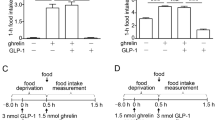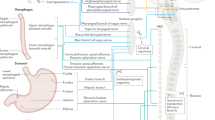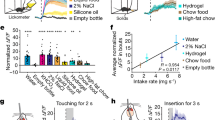Abstract
Neuromedin U (NMU) is a neuropeptide with potent activity on smooth muscle which was isolated first from porcine spinal cord and later from other species1,2,3,4,5,6,7,8. It is widely distributed in the gut and central nervous system9,10. Peripheral activities of NMU include stimulation of smooth muscle1, increase of blood pressure1, alteration of ion transport in the gut11, control of local blood flow12,13 and regulation of adrenocortical function14. An NMU receptor has not been molecularly identified. Here we show that the previously described orphan G-protein-coupled receptor FM-3 (ref. 15) and a newly discovered one (FM-4) are cognate receptors for NMU. FM-3, designated NMU1R, is abundantly expressed in peripheral tissues whereas FM-4, designated NMU2R, is expressed in specific regions of the brain. NMU is expressed in the ventromedial hypothalamus in the rat brain, and its level is significantly reduced following fasting. Intracerebroventricular administration of NMU markedly suppresses food intake in rats. These findings provide a molecular basis for the biochemical activities of NMU and may indicate that NMU is involved in the central control of feeding.
This is a preview of subscription content, access via your institution
Access options
Subscribe to this journal
Receive 51 print issues and online access
$199.00 per year
only $3.90 per issue
Buy this article
- Purchase on Springer Link
- Instant access to full article PDF
Prices may be subject to local taxes which are calculated during checkout





Similar content being viewed by others
References
Minamino, N., Kangawa, K. & Matsuo, H. Neuromedin U-8 and U-25: novel uterus stimulating and hypertensive peptides identified in porcine spinal cord. Biochem. Biophys. Res. Commun. 130, 1078–1085 (1985).
Domin, J., Ghatei, M. A., Chohan, P. & Bloom, S. R. Characterization of neuromedin U like immunoreactivity in rat, porcine, guinea-pig and human tissue extracts using a specific radioimmunoassay. Biochem. Biophys. Res. Commun. 140, 1127–1134 (1986).
Conlon, J. M. et al. Primary structure of neuromedin U from the rat. J. Neurochem. 51, 988–991 (1988).
Minamino, N., Kangawa, K., Honzawa, M. & Matsuo, H. Isolation and structural determination of rat neuromedin U. Biochem. Biophys. Res. Commun. 156, 355–360 ( 1988).
Domin, J. et al. The distribution, purification, and pharmacological action of an amphibian neuromedin U. J. Biol. Chem. 264, 20881–20885 (1989).
O'Harte, F. et al. Primary structure and pharmacological activity of a nonapeptide related to neuromedin U isolated from chicken intestine. Peptides 12, 809–812 ( 1991).
Kage, R., O'Harte, F., Thim, L. & Conlon, J. M. Rabbit neuromedin U-25: lack of conservation of a posttranslational processing site. Regul. Pept. 33, 191–198 (1991).
Domin, J., Benito-Orfila, M. A., Nandha, K. A., Aitken, A. & Bloom, S. R. The purification and sequence analysis of an avian neuromedin U. Regul. Pept. 41, 1–8 (1992).
Honzawa, M., Sudoh, T., Minamino, N., Tohyama, M. & Matsuo, H. Topographic localization of neuromedin U-like structures in the rat brain: an immunohistochemical study. Neuroscience 23, 1103–1122 (1987).
Ballesta, J. et al. Occurrence and developmental pattern of neuromedin U-immunoreactive nerves in the gastrointestinal tract and brain of the rat. Neuroscience 25, 797–816 ( 1988).
Brown, D. R. & Quito, F. L. Neuromedin U octapeptide alters ion transport in porcine jejunum. Eur. J. Pharmacol. 155, 159–162 (1988).
Sumi, S. et al. Effect of synthetic neuromedin U-8 and U-25, novel peptides identified in porcine spinal cord, on splanchnic circulation in dogs. Life Sci. 41, 1585–1590 ( 1987).
Gardiner, S. M., Compton, A. M., Bennett, T., Domin, J. & Bloom, S. R. Regional hemodynamic effects of neuromedin U in conscious rats. Am. J. Physiol. 258 , R32–38 (1990).
Malendowicz, L. K. et al. Effects of neuromedin U (NMU)-8 on the rat hypothalamo-pituitary-adrenal axis. Evidence of a direct effect of NMU-8 on the adrenal gland. Neuropeptides 26, 47–53 (1994).
Tan, C. P. et al. Cloning and characterization of a human and murine T-cell orphan G- protein-coupled receptor similar to the growth hormone secretagogue and neurotensin receptors. Genomics 52, 223–229 (1998).
Retief, J. D., Lynch, K. R. & Pearson, W. R. Panning for genes—A visual strategy for identifying novel gene orthologs and paralogs. Genome Res. 9, 373–382 (1999).
Brady, L. S., Smith, M. A., Gold, P. W. & Herkenham, M. Altered expression of hypothalamic neuropeptide mRNAs in food- restricted and food-deprived rats. Neuroendocrinology 52, 441–447 (1990).
Kristensen, P. et al. Hypothalamic CART is a new anorectic peptide regulated by leptin. Nature 393, 72– 76 (1998).
Zhang, Y. et al. Positional cloning of the mouse obese gene and its human homologue. Nature 372, 425–432 (1994).
Chavez, M., Seeley, R. J. & Woods, S. C. A comparison between effects of intraventricular insulin and intraperitoneal lithium chloride on three measures sensitive to emetic agents. Behav. Neurosci. 109, 547 –550 (1995).
Stricker, E. M. & Verbalis, J. G. in Handbook of Behavioural Neurobiology of Food and Fluid Intake (ed. Stricker, E. M.) 45–60 (Plenum, New York, 1990).
Kissileff, H. R. Food-associated drinking in the rat. J. Comp. Physiol. Psychol. 67, 284–300 ( 1969).
Button, D. & Brownstein, M. Aequorin-expressing mammalian cell lines used to report Ca2+ mobilization. Cell. Calcium 14, 663–671 ( 1993).
Liu, Q. et al. Identification of urotensin II as the endogenous ligand for the orphan G-protein-coupled receptor GPR14. Biochem. Biophys. Res. Commun. 266, 174–178 ( 1999).
Ungrin, M. D., Singh, L. M., Stocco, R., Sas, D. E. & Abramovitz, M. An automated aequorin luminescence-based functional calcium assay for G-protein-coupled receptors. Anal. Biochem. 272, 34–42 (1999).
Guan, X. M., Yu, H. & Van der Ploeg, L. H. Evidence of altered hypothalamic pro-opiomelanocortin/neuropeptide Y mRNA expression in tubby mice. Brain Res. Mol. Brain Res. 59, 273–279 (1998).
Murphy, B. et al. Melanocortin mediated inhibition of feeding behavior in rats. Neuropeptides 32, 491– 497 (1998).
Acknowledgements
We thank M. Abramowitz and R. Stocco of Merck Frosst Canada for setting up the aequorin assay.
Author information
Authors and Affiliations
Corresponding author
Rights and permissions
About this article
Cite this article
Howard, A., Wang, R., Pong, SS. et al. Identification of receptors for neuromedin U and its role in feeding . Nature 406, 70–74 (2000). https://doi.org/10.1038/35017610
Received:
Accepted:
Issue Date:
DOI: https://doi.org/10.1038/35017610
This article is cited by
-
Group 2 innate lymphoid cells and their surrounding environment
Inflammation and Regeneration (2023)
-
Moniezia benedeni infection enhances neuromedin U (NMU) expression in sheep (Ovis aries) small intestine
BMC Veterinary Research (2022)
-
Neuromedin U promotes human type 2 immune responses
Mucosal Immunology (2022)
-
Neuromedin U-deficient rats do not lose body weight or food intake
Scientific Reports (2022)
-
Role of neuropeptide neuromedin U in the nucleus accumbens shell in cocaine self-administration in male rats
Neuropsychopharmacology (2022)
Comments
By submitting a comment you agree to abide by our Terms and Community Guidelines. If you find something abusive or that does not comply with our terms or guidelines please flag it as inappropriate.



